Welcome to your comprehensive guide to Star Trek uniforms! From the early days of Starfleet to potential futures, the uniforms worn by Starfleet officers have been as iconic and evolving as the series itself. This guide provides a visual and descriptive journey through the diverse styles and variations of Starfleet uniforms across different eras of Star Trek canon.
At last count, there are at least twelve official Starfleet uniform designs recognized within Star Trek canon. These designs feature numerous color codes to distinguish departments, variations for alternate realities and potential future timelines, and even fan-created custom uniforms. This article focuses on the main, canon uniform evolutions to provide a clear and concise overview.
This guide aims to be your quick, graphical reference to the evolution of the Starfleet uniform, covering key eras and design changes.
Types of Uniforms
Across most Star Trek eras, Starfleet personnel typically wear two primary uniform types: duty uniforms and dress uniforms.
- Duty Uniforms: These are the standard uniforms worn during active duty shifts, such as on the bridge of a starship or in engineering. They are designed for practicality and everyday wear while performing official duties.
- Dress Uniforms: Dress uniforms are reserved for formal occasions. These might include diplomatic events, weddings, ceremonial proceedings, and court appearances. They represent a more formal and presentable attire for Starfleet officers in official settings.
In some periods, additional uniform variations exist to serve specific purposes:
- Service or Work Uniforms: These uniforms are sometimes used for specific tasks, particularly those involving manual labor or potentially hazardous work. Medical personnel frequently wore distinct lab coats or differently colored uniforms when on duty in sickbay, and engineering staff might have similar work-specific attire.
- Casual Duty Variants: Captains and occasionally other senior officers sometimes have access to more relaxed uniform styles for duty. These could include wrap-around tunics or jackets that offer a less formal alternative to the standard duty uniform while still maintaining a Starfleet aesthetic.
- Cadet Uniforms: Students attending Starfleet Academy typically wear a unique uniform or insignia that identifies their cadet status. This helps distinguish trainees from active Starfleet officers.
Ranks
Starfleet’s rank system is based on naval ranks, reflecting its exploratory and, at times, military functions.
Line Officers: These commissioned officers are assigned to specific posts, usually a starship or starbase, for which they are directly responsible.
- Captains: Captains hold command of starships. Each starship is typically under the command of a captain.
- Commanders: Commanders often serve as executive officers on starships, working under captains. They may be officers aspiring to captain rank and their own command. In some cases, a commander may be in charge of a space station, colony, or similar installation. When a commander is in command of a starship, they are designated “acting captain.”
- Lieutenants and Ensigns: These are junior officers. Ensign is generally the entry-level rank for graduates of Starfleet Academy. Lieutenant ranks exist above ensign, indicating increasing levels of experience and responsibility.
Other ranks exist within Starfleet, though they aren’t always consistently depicted across all series:
- Lieutenant Commander: A rank between Lieutenant and Commander. They are often addressed informally as “Commander,” especially by junior officers.
- Lieutenant Junior Grade: A rank sometimes recognized as falling between Ensign and Lieutenant.
Flag Officers: These ranks are above Captain and are not assigned to a single ship. They command larger formations and sectors.
- Commodore/Fleet Captain: Commodore is the lowest flag officer rank, positioned between Captain and Admiral. Commodores command multiple ships in field operations. The term “Fleet Captain” is sometimes used interchangeably or as a renamed version of Commodore.
- Admirals: Admirals command fleets of starships, entire sectors of space, or major divisions within Starfleet. Admiral ranks are further subdivided in ascending order: Rear Admiral, Vice Admiral, Admiral, and Fleet Admiral.
- Fleet Admiral/Commander in Chief of Starfleet: Fleet Admirals are the highest-ranking officers, with the senior Fleet Admiral serving as the Commander in Chief of Starfleet, reporting directly to the Federation Council and President.
Non-Commissioned Officers (“Noncoms”): These crewmembers have not graduated from Starfleet Academy.
- Noncom Ranks: In some instances, noncoms are not explicitly distinguished in rank and may be treated similarly to Ensigns or without visible rank insignia. When differentiation is necessary, ranks such as Crewman, Specialist, Petty Officer, Chief Petty Officer, Senior Chief Petty Officer, and Master Chief Petty Officer are used.
- Senior Noncoms: Higher-ranking noncoms, like Senior and Master Chiefs, can possess extensive experience and be considered part of the senior staff on starships or starbases. Despite their experience, they technically rank below a newly commissioned Ensign.
Warrant Officers: Theoretically, Warrant Officers exist in Starfleet. These are specialists whose expertise grants them a quasi-commission. While not Academy graduates, a Warrant Officer’s rank would be equivalent to Ensign, Lieutenant, or higher, based on their specialization. However, no Warrant Officers have been explicitly identified as such in Star Trek canon. Provisional or honorary ranks may serve a similar function within Starfleet.
2150s
Where It Was Seen: Star Trek: Enterprise
Description: The United Earth Starfleet uniform in the 2150s is a practical, navy blue jumpsuit. This uniform was standard issue until the formation of the United Federation of Planets, encompassing the Earth-Romulan War era. Notably, this is one of the few Starfleet uniform designs to incorporate functional pockets.
Division Colors: Departmental affiliation is indicated by a colored strip framing the shoulders. Yellow denotes command, red signifies operations (including security and engineering), and teal represents sciences (medical and science divisions).
Badge: Officers wore circular assignment patches on the left arm to indicate their assigned starship.
Rank: Rank was displayed through rectangular pips located on the upper right breast of the uniform.
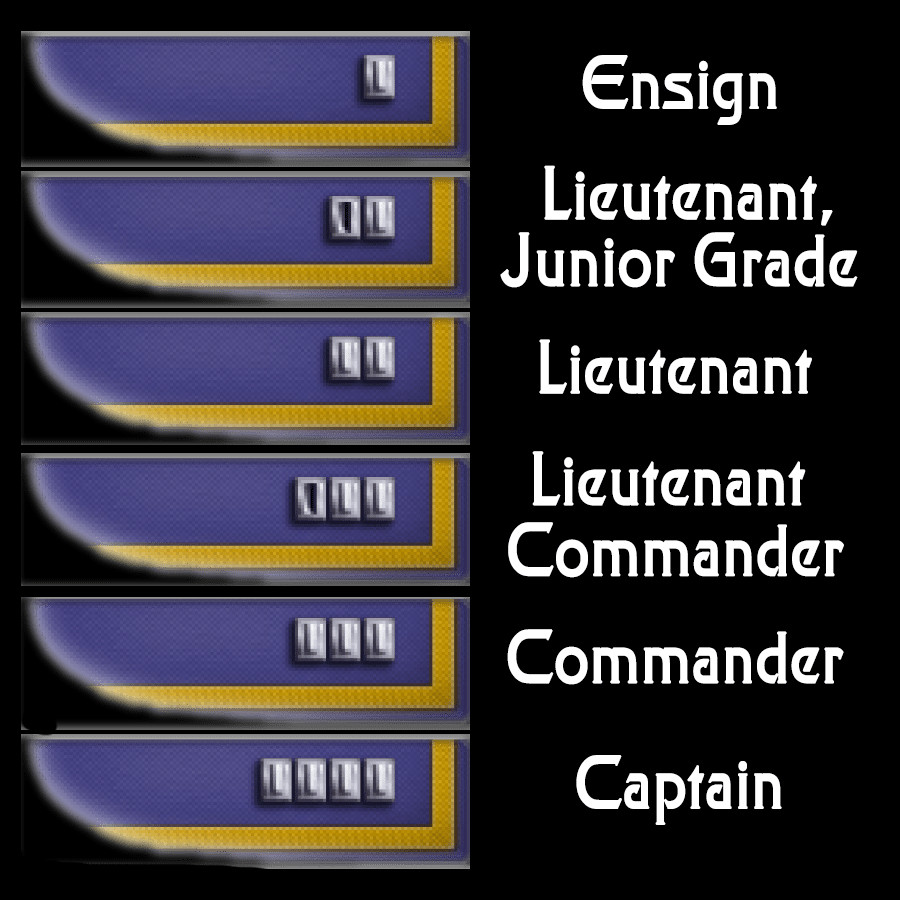 Starfleet Ranks 2150s: Ensign, Lieutenant, Commander, Captain, Admiral
Starfleet Ranks 2150s: Ensign, Lieutenant, Commander, Captain, Admiral
2160s
Where It Was Seen: Star Trek Beyond
Description: Likely the inaugural uniform of the newly formed United Federation Starfleet, this design retains a utilitarian jumpsuit style. It is light grey and features colored patches on the shoulders and cuffs, along with stripes running down the chest and pant legs. The assignment patch on the upper arm is carried over from the Earth Starfleet uniform, continuing to denote the officer’s ship assignment.
Division Colors: Patches and stripes indicate department: yellow for command, red for operations, and blue for sciences.
Badge: Gold pins in the shape of the Starfleet delta insignia were worn on the left breast.
Rank: Rank insignia for this uniform style remain unknown, as no rank emblems were visible on-screen.
2230s
 2230s Starfleet Uniform: Color-coded tunics with dark trousersWhere It Was Seen: Star Trek (Kelvin Timeline – 2009 film)
2230s Starfleet Uniform: Color-coded tunics with dark trousersWhere It Was Seen: Star Trek (Kelvin Timeline – 2009 film)
Description: A minimalist evolution from the jumpsuit era, this uniform transitions to a two-piece design. It features dark trousers paired with a colored tunic. A raised stripe of piping adds detail along the upper arms and across the chest.
Division Colors: The tunic color denotes the officer’s department. Blue is for command, tan/gold for operations, and grey for sciences.
Badge: A raised, silver outline of the Starfleet delta insignia is positioned on the left breast.
Rank: Metallic bands on the tunic sleeves indicate rank.
2240s
Where It Was Seen: Star Trek: Discovery
Description: This uniform is a form-fitting, two-piece blue design with metallic accents on the shoulders and along the sides of the torso.
Division Colors: The hue of the metallic highlights signifies department. Gold is for command, silver for sciences, and bronze for operations.
Badge: Two-piece metallic insignia badges are worn on the left breast. The color of the badge matches the metallic department color used on the uniform.
Rank: Raised bumps on the insignia badge denote officer rank. Captains have additional gold highlights on their shoulders.
Note: While chronologically these uniforms should align with those seen in early Star Trek: The Original Series, tie-in materials explain that these more vibrant uniforms were newer diplomatic versions being introduced, starting with Constitution-class exploratory starships.
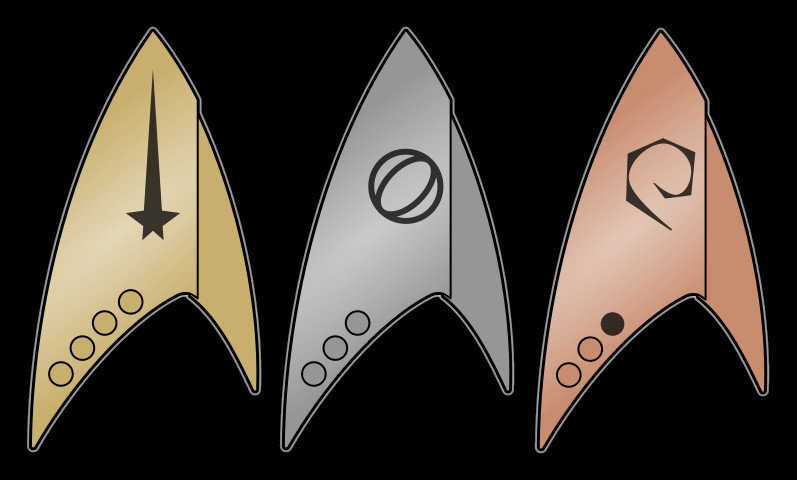 Starfleet Insignia Badges from 2240s (Discovery) and 2270s (Motion Picture)
Starfleet Insignia Badges from 2240s (Discovery) and 2270s (Motion Picture)
Second Note: In Discovery, officers with black badges are seen. Their affiliation was not clarified on-screen, but a deleted scene identified the black badge as belonging to Section 31, Starfleet’s clandestine intelligence division. The rationale for Section 31 wearing identifiable Starfleet badges remains unexplained, given their covert nature as a supposedly separate organization.
2250s
Where It Was Seen: Star Trek: The Original Series (pilot episodes: “The Cage” and “Where No Man Has Gone Before”)
Description: This early TOS uniform consists of a colored turtleneck sweater paired with dark trousers.
Division Colors: The color of the turtleneck shirt indicates division. Yellow is for command, blue for science, and tan for operations.
Badge: An assignment patch is worn on the left breast. It’s unclear if each ship had a unique patch during this period, as in the 2260s, or if all ships used the Starfleet delta.
Rank: Golden braids on the sleeves indicate rank. Not all ranks were depicted on-screen during the brief period these uniforms were used.
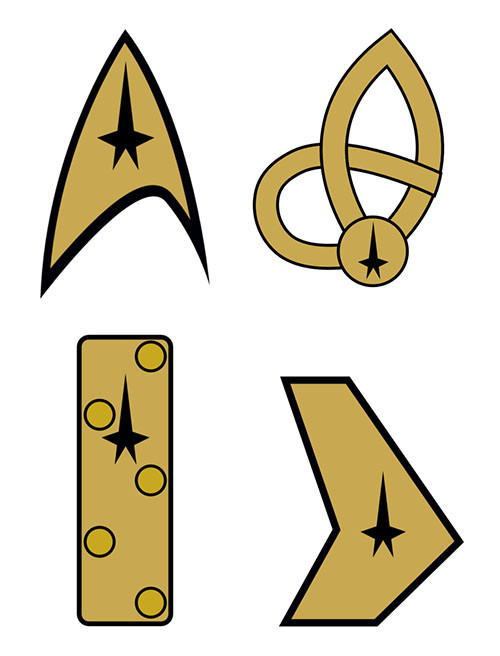 Starfleet Assignment Patch – Likely from 2250s or 2260s era
Starfleet Assignment Patch – Likely from 2250s or 2260s era
2260s
Where It Was Seen: Star Trek: The Original Series
Description: A brightly colored shirt with a black collar and dark trousers defines this iconic uniform era.
Division Colors: The shirt color designates department: yellow for command, blue for science, red for operations.
Badge: Instead of a standard Starfleet delta insignia, ships and starbases used unique assignment patches on the left breast. The U.S.S. Enterprise, as the Federation flagship, retained the delta insignia.
Rank: Golden braids on the shirt cuffs indicate rank.
Note: This uniform is synonymous with The Original Series and is also theoretically represented in the Kelvin Timeline films. In the first two Kelvin films, the black collar is replaced with a black undershirt, and the colored top features a textured pattern of Starfleet deltas. In Star Trek Beyond, the top is redesigned as a heavier jacket with a high collar.
 Starfleet Ranks 2260s: Ensign, Lieutenant, Lieutenant Commander, Commander, Captain, Admiral
Starfleet Ranks 2260s: Ensign, Lieutenant, Lieutenant Commander, Commander, Captain, Admiral
2270s
Where It Was Seen: Star Trek: The Motion Picture
Description: Uniforms in this era shift to muted tones of blue, white, beige, or grey. They were produced as jumpsuits or two-piece sets with matching tops and trousers.
Division Colors: Department is indicated by the color of the circle behind the printed Starfleet insignia. White signifies command, orange is for sciences, green for medical, red for engineering, yellow for communications and helm/navigation, and grey for security.
Badge: The Starfleet insignia is printed directly onto the left breast of the uniform.
Rank: Golden braids on the sleeves or shoulder patches denote rank.
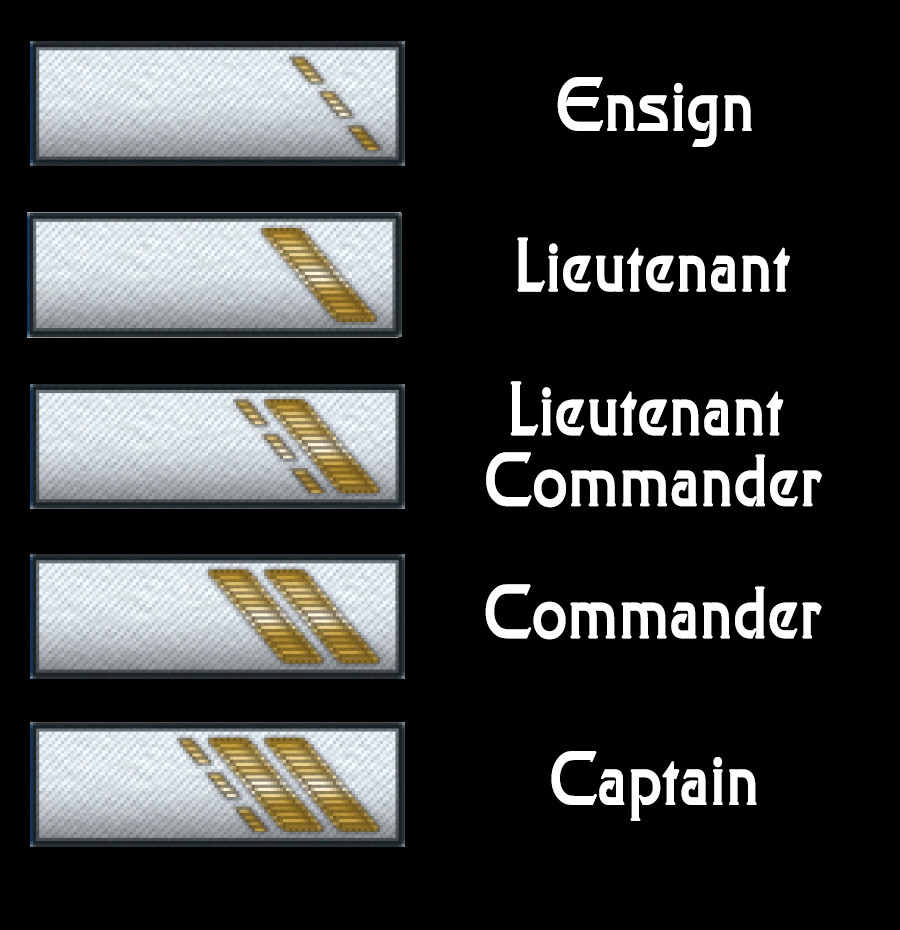 Starfleet Ranks 2270s: Lieutenant, Captain, Admiral
Starfleet Ranks 2270s: Lieutenant, Captain, Admiral
2280s
Where It Was Seen: Star Trek II: The Wrath of Khan onwards (through Star Trek VI: The Undiscovered Country)
Description: A crimson tunic worn over a color-coded turtleneck undershirt is the defining feature of this long-lasting uniform. The uniform includes dark trousers with a colored stripe down the leg that matches the undershirt color (except for command officers, who have a red stripe).
Division Colors: Department is identified by the color of the undershirt, shoulder clasp, and trouser stripe. White is for command; grey for sciences, communication, and navigation; ochre for engineering and helm; light green for medical; dark green for security; and red for cadets and junior officers. Non-commissioned officers wore jumpsuits but also had black undershirts.
Badge: A metal Starfleet insignia variant with a large rectangular backing is worn on the left breast.
Rank: A metal rank badge is worn on a shoulder clasp.
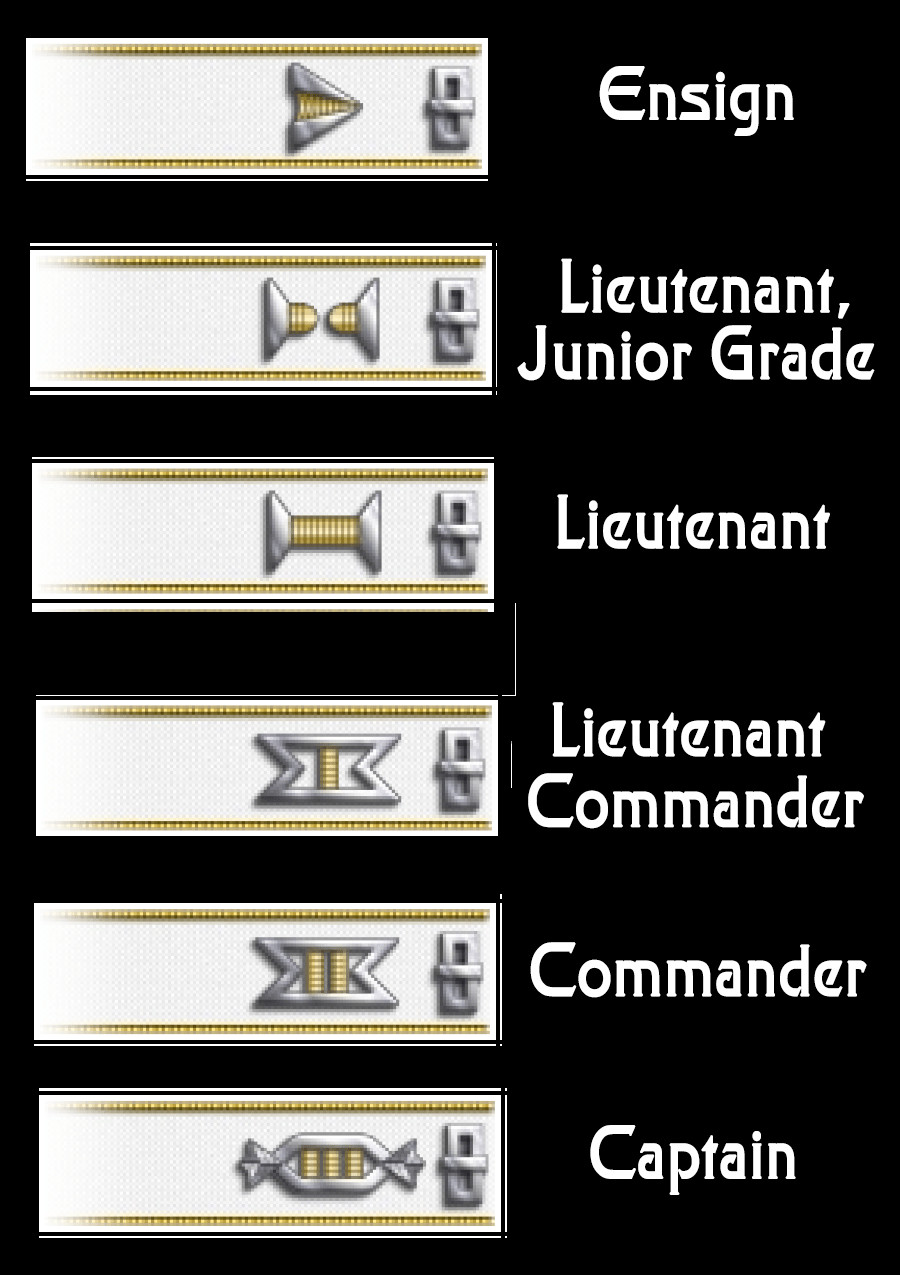 Starfleet Ranks 2280s: Ensign, Lieutenant, Commander, Captain, Admiral
Starfleet Ranks 2280s: Ensign, Lieutenant, Commander, Captain, Admiral
Note: This uniform design was used extensively until the 2350s. In later years of its use, the belt and turtleneck were phased out, and the insignia pin was replaced by the combadge.
Early 2360s
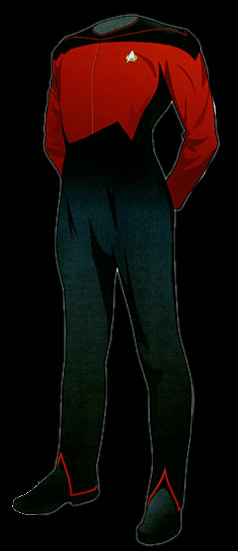 Early 2360s Starfleet Uniform: One-piece jumpsuit with color-blocked upper sectionWhere It Was Seen: Star Trek: The Next Generation (seasons 1-2)
Early 2360s Starfleet Uniform: One-piece jumpsuit with color-blocked upper sectionWhere It Was Seen: Star Trek: The Next Generation (seasons 1-2)
Description: The initial Next Generation uniform is a tight, one-piece jumpsuit with a low collar. The chest, back, and sleeves are brightly colored, as is a stripe running along the collarbone and shoulders.
Division Colors: The color of the upper jumpsuit section denotes department. Red is for command, yellow for operations, and blue for sciences.
Badge: All officers wear a combadge: a silver delta backed with a golden oval, which also functions as a communicator.
Rank: Round gold pips on the upper right breast indicate rank.
Late 2360s
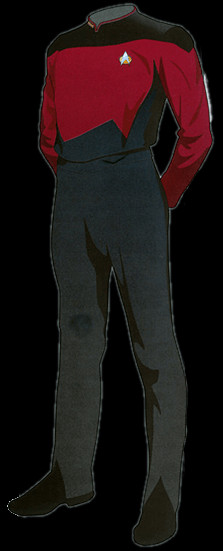 Late 2360s Starfleet Uniform: Two-piece with colored jacket and black undershirtWhere It Was Seen: Star Trek: The Next Generation (seasons 3 onwards)
Late 2360s Starfleet Uniform: Two-piece with colored jacket and black undershirtWhere It Was Seen: Star Trek: The Next Generation (seasons 3 onwards)
Description: A more relaxed, two-piece modification of the earlier jumpsuit. This version features a separate jacket and trousers with a high collar.
Division Colors: The jacket color is associated with department: red for command, yellow for operations, and blue for sciences.
Badge: A combadge, shaped like a silver delta with a golden oval backing, is worn on the left breast.
Rank: Gold pips worn on the right collar indicate officer rank.
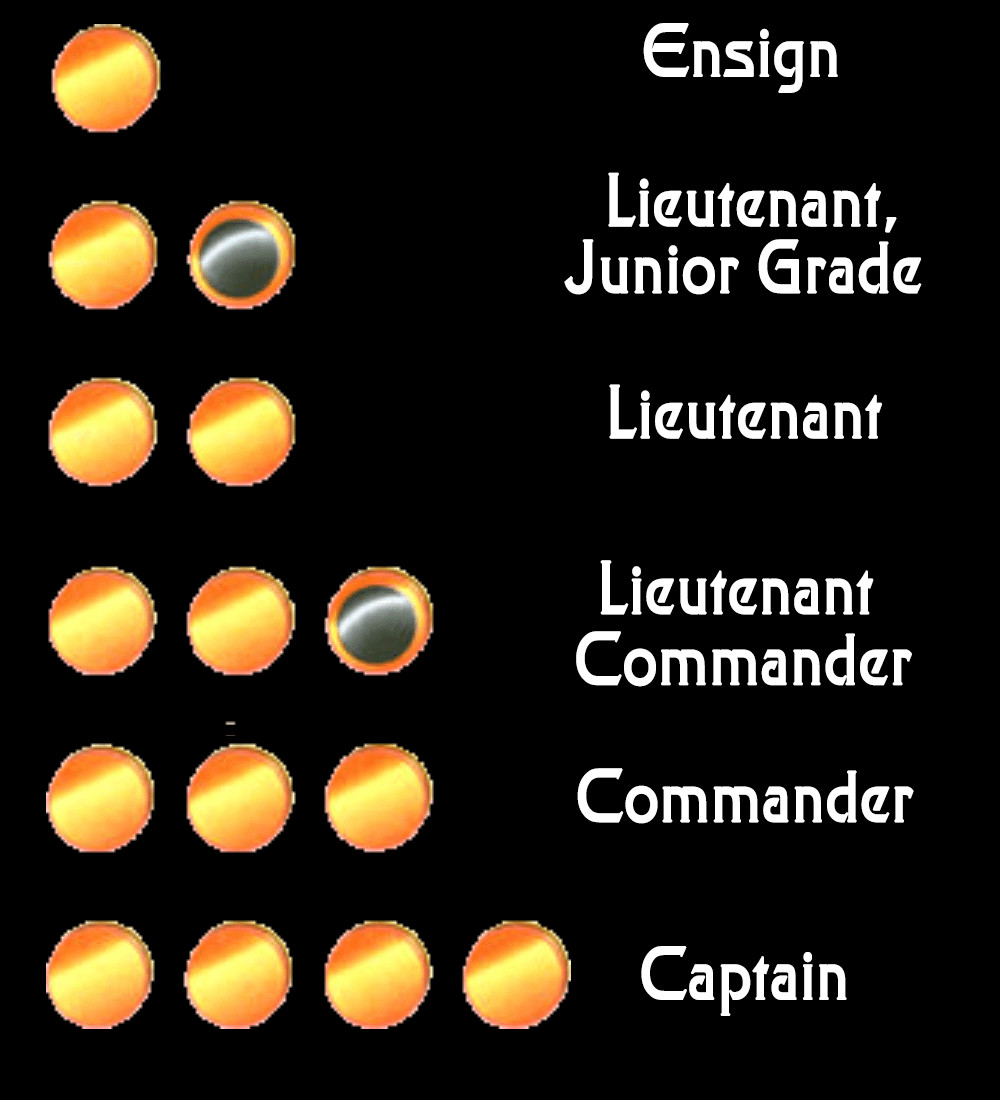 Starfleet Ranks 2360s: Ensign, Lieutenant, Lieutenant Commander, Commander, Captain, Admiral
Starfleet Ranks 2360s: Ensign, Lieutenant, Lieutenant Commander, Commander, Captain, Admiral
2360s (Variant – “DS9/Voyager” Style)
Where It Was Seen: Star Trek: Deep Space Nine and Star Trek: Voyager
Description: This variant consists of dark trousers and a jacket worn over a blue-grey turtleneck undershirt. The shoulders of the jacket are brightly colored.
Division Colors: Shoulder color denotes department. Red for command, yellow for operations, and blue/teal for sciences.
Badge: A combadge is worn on the left breast. Initially, it was the silver delta with a golden oval. Later in the late 2360s and early 2370s, an updated model replaced the oval with a trapezoidal shape.
Rank: Gold pips on the right collar of the undershirt indicate rank.
Note: This variant served as a service dress or “work uniform.” It was commonly worn on less formal assignments like space stations and colonies where more practical, “hands-on” work might be expected. As the standard duty uniform was being phased out, this variant saw widespread use for a year or two.
2370s
Where It Was Seen: Star Trek: First Contact; Star Trek: Deep Space Nine (seasons 5 onwards)
Description: This uniform features a dark jacket with light grey shoulders and matching trousers, worn over a colored undershirt.
Division Colors: The undershirt color is associated with department. Red for command, yellow for operations, and blue for sciences.
Badge: Combadge worn on the left breast: a silver Starfleet delta backed by a gold trapezoid.
Rank: Round gold pips worn on the right collar of the undershirt signify rank.
2380s
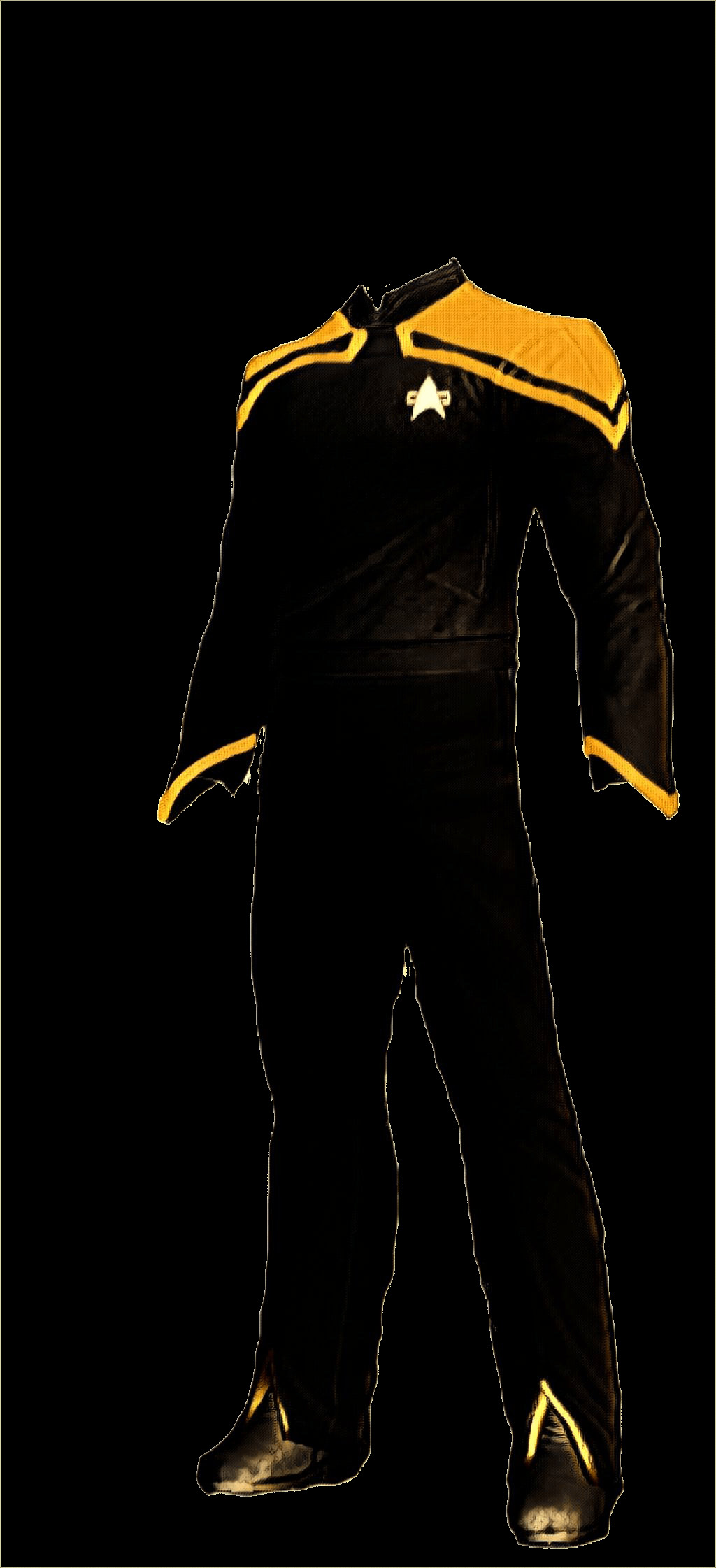 2380s Starfleet Uniform: Dark jacket with colored shoulders and cuff bandsWhere It Was Seen: Star Trek: Picard (season 1)
2380s Starfleet Uniform: Dark jacket with colored shoulders and cuff bandsWhere It Was Seen: Star Trek: Picard (season 1)
Description: A dark jacket with matching trousers featuring colored shoulders and bands along the flared cuffs.
Division Colors: Shoulder and cuff colors denote department. Red for command, yellow for operations, and blue for sciences.
Badge: Combadge worn on the left breast: silver Starfleet delta with a gold trapezoid backing.
Rank: Round gold pips worn on the right collar of the undershirt signify rank.
2390s (Alternate Timeline)
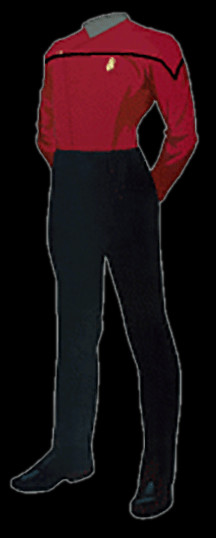 Alternate 2390s Starfleet Uniform: Double-breasted jacket with pipingWhere It Was Seen: Seen in potential future timelines in Star Trek: The Next Generation.
Alternate 2390s Starfleet Uniform: Double-breasted jacket with pipingWhere It Was Seen: Seen in potential future timelines in Star Trek: The Next Generation.
Description: A double-breasted jacket with high-waisted dark trousers. Black piping runs along the chest and shoulders.
Division Colors: Jacket color indicates department. Red for command, blue for science, and yellow for operations.
Badge: A combadge is worn on the left breast. This badge is a silver outline of a delta backed by two gold trapezoids.
Rank: Gold round pips are worn on the upper right breast, above the black piping.
2390s (Standard Timeline)
 2390s Starfleet Uniform: Dark jacket with colored shoulders and black undershirtWhere It Was Seen: Star Trek: Picard (season 2 & 3)
2390s Starfleet Uniform: Dark jacket with colored shoulders and black undershirtWhere It Was Seen: Star Trek: Picard (season 2 & 3)
Description: Dark trousers and a jacket worn over a black turtleneck undershirt. The jacket shoulders are brightly colored.
Division Colors: Shoulder color denotes department. Red for command, yellow for operations, and blue for sciences.
Badge: A combadge is worn on the left breast. This badge is a silver outline of a delta backed by two silver trapezoids.
Rank: Silver round pips are worn on the upper right breast.
2410s (Potential Future)
Where It Was Seen: Star Trek Online
Description: A dark jacket and trousers worn over a colored undershirt. The jacket has a high collar with a wide band of color running along the chest and shoulders. On standard officers, the shoulders above the colored band are dark grey, while commanding officers have white shoulders.
Division Colors: The undershirt and colored band signify department. Red is for command, blue for sciences, and yellow for operations.
Badge: A combadge is worn on the left breast, shaped like a solid silver delta.
Rank: Silver rectangular pips are located on the right collar.
This guide provides a visual and descriptive overview of the main Starfleet uniform variations. The evolution of these uniforms reflects not only changes in style but also the ongoing story and technological advancements within the Star Trek universe.
